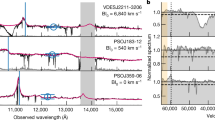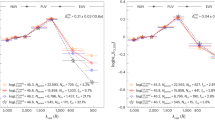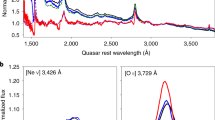Abstract
Quasar outflows carry mass, momentum and energy into the surrounding environment, and have long been considered a potential key factor in regulating the growth of supermassive black holes and the evolution of their host galaxies1,2,3,4. A crucial parameter for understanding the origin of these outflows and measuring their influence on their host galaxies is the distance R between the outflow gas and the galaxy centre5,6. Although R has been measured in a number of individual galaxies7,8,9,10,11,12,13,14,15, its distribution remains unknown. Here we report the distributions of R and the kinetic luminosities of quasar outflows, using the statistical properties of broad absorption line variability in a sample of 915 quasars from the Sloan Digital Sky Survey. The mean and standard deviation of the distribution of R are 101.4±0.5 parsecs. The typical outflow distance in this sample is tens of parsecs, which is beyond the theoretically predicted location (0.01 to 0.1 parsecs) at which the accretion disk line-driven wind is launched16,17, but is smaller than the scales of most outflows that are derived using the excited-state absorption lines7,8,9,10,11,12,13,14. The typical value of the mass flow rate is tens to a hundred solar masses per year, or several times the accretion rate. The typical kinetic-to-bolometric luminosity ratio is a few per cent, indicating that outflows are energetic enough to influence the evolution of their host galaxies.
This is a preview of subscription content, access via your institution
Access options
Access Nature and 54 other Nature Portfolio journals
Get Nature+, our best-value online-access subscription
$29.99 / 30 days
cancel any time
Subscribe to this journal
Receive 12 digital issues and online access to articles
$119.00 per year
only $9.92 per issue
Buy this article
- Purchase on Springer Link
- Instant access to full article PDF
Prices may be subject to local taxes which are calculated during checkout


Similar content being viewed by others
Data availability
The data that support the plots within this paper and other findings of this study are available from the corresponding author upon reasonable request.
References
Scannapieco, E. & Oh, S. P. Quasar feedback: the missing link in structure formation. Astrophys. J. 608, 62 (2004).
Murray, N., Quataert, E. & Thompson, T. A. On the maximum luminosity of galaxies and their central black holes: feedback from momentum-driven winds. Astrophys. J. 618, 569 (2005).
Ciotti, L., Ostriker, J. P. & Proga, D. Feedback from central black holes in elliptical galaxies. I. Models with either radiative or mechanical feedback but not both. Astrophys. J. 699, 89 (2009).
Ostriker, J. P., Choi, E., Ciotti, L., Novak, G. S. & Proga, D. Momentum driving: which physical processes dominate active galactic nucleus feedback? Astrophys. J. 722, 642 (2010).
Hopkins, P. F. & Elvis, M. Quasar feedback: more bang for your buck. Mon. Not. R. Astron. Soc. 401, 7–14 (2009).
Di Matteo, T., Springel, V. & Hernquist, L. Energy input from quasars regulates the growth and activity of black holes and their host galaxies. Nature 433, 604 (2005).
Arav, N. et al. Measuring column densities in quasar outflows: VLT observations of QSO 2359–1241. Astrophys. J. 681, 954 (2008).
Moe, M., Arav, N., Bautista, M. A. & Korista, K. T. Quasar outflow contribution to AGN feedback: observations of QSO SDSS J0838+ 2955. Astrophys. J. 706, 525 (2009).
Hamann, F. et al. A high-velocity narrow absorption line outflow in the quasar J212329.46-005052.9. Mon. Not. R. Astron. Soc. 410, 1957–1974 (2011).
Borguet, B. C., Edmonds, D., Arav, N., Dunn, J. & Kriss, G. A. A 10 kpc scale Seyfert galaxy outflow: HST/COS observations of IRAS F22456–5125. Astrophys. J. 751, 107 (2012).
Arav, N. et al. Anatomy of the AGN in NGC 5548. II. The spatial, temporal, and physical nature of the outflow from HST/COS observations. Astron. Astrophys. 577, A37 (2015).
Chamberlain, C., Arav, N. & Benn, C. Strong candidate for AGN feedback: VLT/X-shooter observations of BALQSO SDSS J0831+ 0354. Mon. Not. R. Astron. Soc. 450, 1085–1093 (2015).
Arav, N. et al. Evidence that 50% of BALQSO outflows are situated at least 100 pc from the central source. Astrophys. J. 857, 60 (2018).
Xu, X., Arav, N., Miller, T. & Benn, C. VLT/X-shooter survey of BAL quasars: large distance scale and AGN feedback. Preprint at https://arxiv.org/abs/1805.01544 (2018).
He, Z., Liu, G., Wang, T., Yang, C. & Sheng, Z. Leaked Lyα emission: an indicator of the size of quasar absorption outflows. Astrophys. J. 839, 77 (2017).
Murray, N., Chiang, J., Grossman, S. & Voit, G. Accretion disk winds from active galactic nuclei. Astrophys. J. 451, 498 (1995).
Proga, D., Stone, J. M. & Kallman, T. R. Dynamics of line-driven disk winds in active galactic nuclei. Astrophys. J. 543, 686 (2000).
Gibson, R. R., Brandt, W., Gallagher, S. & Schneider, D. P. X-ray insights into the physics of mini-BAL quasar outflows. Astrophys. J. 696, 924 (2009).
Allen, J. T., Hewett, P. C., Maddox, N., Richards, G. T. & Belokurov, V. A strong redshift dependence of the broad absorption line quasar fraction. Mon. Not. R. Astron. Soc. 410, 860–884 (2010).
Capellupo, D. M., Hamann, F., Shields, J. C., Rodríguez Hidalgo, P. & Barlow, T. A. Variability in quasar broad absorption line outflows—I. Trends in the short-term versus long-term data. Mon. Not. R. Astron. Soc. 413, 908–920 (2011).
Capellupo, D. M., Hamann, F., Shields, J. C., Rodríguez Hidalgo, P. & Barlow, T. A. Variability in quasar broad absorption line outflows—II. Multi-epoch monitoring of Si iv and C iv broad absorption line variability. Mon. Not. R. Astron. Soc. 422, 3249–3267 (2012).
Filiz, Ak,N. et al. Broad absorption line disappearance on multi-year timescales in a large quasar sample. Astrophys. J. 757, 114 (2012).
Filiz, Ak,N. et al. Broad absorption line variability on multi-year timescales in a large quasar sample. Astrophys. J. 777, 168 (2013).
He, Z.-C., Bian, W.-H., Ge, X. & Jiang, X.-L. Variability of QSOs with variable regions in broad absorption troughs from the Sloan Digital Sky Survey. Mon. Not. R. Astron. Soc. 454, 3962–3976 (2015).
Hemler, Z. S. et al. The Sloan Digital Sky Survey reverberation mapping project: systematic investigations of short-timescale CIV broad absorption line variability. Preprint at https://arxiv.org/abs/1811.00010 (2018).
Wang, T., Yang, C., Wang, H. & Ferland, G. Evidence for photoionization-driven broad absorption line variability. Astrophys. J. 814, 150 (2015).
He, Z. et al. Variation of ionizing continuum: the main driver of broad absorption line variability. Astrophys. J. Suppl. Ser. 229, 22 (2017).
Barlow, T. A. et al. Broad absorption-line time variability in the QSO CSO 203. Astrophys. J. 397, 81–87 (1992).
Krolik, J. H. & Kriss, G. A. Observable properties of X-ray heated winds in AGN: warm reflectors and warm absorbers. Astrophys. J. 447, 512 (1995).
Nomura, M. & Ohsuga, K. Line-driven disk wind model for ultra-fast outflows in active galactic nuclei—scaling with luminosity. Mon. Not. R. Astron. Soc. 465, 2873–2879 (2016).
MacLeod, C. L. et al. Modeling the time variability of SDSS Stripe 82 quasars as a damped random walk. Astrophys. J. 721, 1014 (2010).
Kelly, B. C., Bechtold, J. & Siemiginowska, A. Are the variations in quasar optical flux driven by thermal fluctuations? Astrophys. J. 698, 895 (2009).
Kozłowski, S. et al. Quantifying quasar variability as part of a general approach to classifying continuously varying sources. Astrophys. J. 708, 927 (2009).
Guo, H., Wang, J., Cai, Z. & Sun, M. How far is quasar UV/optical variability from a damped random walk at low frequency? Astrophys. J. 847, 132 (2017).
Shen, Y. et al. A catalog of quasar properties from Sloan Digital Sky Survey data release 7. Astrophys. J. Suppl. Ser. 194, 45 (2011).
Pâris, I. et al. The Sloan Digital Sky Survey quasar catalog: twelfth data release. Astron. Astrophys. 597, A79 (2017).
Dawson, K. S. et al. The baryon oscillation spectroscopic survey of SDSS-III. Astron. J. 145, 10 (2013).
Abolfathi, B. et al. The fourteenth data release of the Sloan Digital Sky Survey: first spectroscopic data from the extended baryon oscillation spectroscopic survey and from the second phase of the Apache Point Observatory galactic evolution experiment. Astrophys. J. Suppl. Ser. 235, 42 (2018).
Margala, D. et al. Improved spectrophotometric calibration of the SDSS-III Boss quasar sample. Astrophys. J. 831, 157 (2016).
Shen, Y. et al. The Sloan Digital Sky Survey reverberation mapping project: technical overview. Astrophys. J. Suppl. Ser. 216, 4 (2014).
Arav, N., Korista, K. T., De Kool, M., Junkkarinen, V. T. & Begelman, M. C. Hubble space telescope observations of the broad absorption line quasar PG 0946+ 301. Astrophys. J. 516, 27 (1999).
Hall, P. B. et al. Unusual broad absorption line quasars from the Sloan Digital Sky Survey. Astrophys. J. Suppl. Ser. 141, 267 (2002).
Arav, N., Borguet, B., Chamberlain, C., Edmonds, D. & Danforth, C. Quasar outflows and AGN feedback in the extreme UV: HST/COS observations of HE 0238-1904. Mon. Not. R. Astron. Soc. 436, 3286–3305 (2013).
Leighly, K. M., Terndrup, D. M., Gallagher, S. C., Richards, G. T. & Dietrich, M. The z = 0.54 loBAL quasar SDSS J085053.12+445122.5: I. Spectral synthesis analysis reveals a massive outflow. Preprint at https://arxiv.org/abs/1808.02441 (2018).
Savage, B. D. & Sembach, K. R. The analysis of apparent optical depth profiles for interstellar absorption lines. Astrophys. J. 379, 245–259 (1991).
Rogerson, J. A. et al. Emergence and variability of broad absorption line quasar outflows. Astrophys. J. 862, 22 (2018).
Ferland, G. et al. The 2013 release of Cloudy. Rev. Mex. Astron. 49, 137–163 (2013).
Mushotzky, R. F., Edelson, R., Baumgartner, W. & Gandhi, P. Kepler observations of rapid optical variability in active galactic nuclei. Astrophys. J. Lett. 743, L12 (2011).
Kasliwal, V. P., Vogeley, M. S. & Richards, G. T. Are the variability properties of the Kepler AGN light curves consistent with a damped random walk? Mon. Not. R. Astron. Soc. 451, 4328–4345 (2015).
Steenbrugge, K., Feňovčík, M., Kaastra, J., Costantini, E. & Verbunt, F. High-resolution X-ray spectroscopy of the low and high states of the Seyfert 1 galaxy NGC 4051 with Chandra LETGS. Astron. Astrophys. 496, 107–119 (2009).
Detmers, R. et al. Multiwavelength campaign on Mrk 509—III. The 600 ks RGS spectrum: unravelling the inner region of an AGN. Astron. Astrophys. 534, A38 (2011).
Mathews, W. G. & Ferland, G. J. What heats the hot phase in active nuclei? Astrophys. J. 323, 456–467 (1987).
Dunn, J. P. et al. The quasar outflow contribution to AGN feedback: VLT measurements of SDSS J0318-0600. Astrophys. J. 709, 611 (2010).
Arav, N. et al. Chemical abundances in an AGN environment: X-ray/UV campaign on the Markarian 279 outflow. Astrophys. J. 658, 829 (2007).
Borguet, B. C., Edmonds, D., Arav, N., Benn, C. & Chamberlain, C. BAL phosphorus abundance and evidence for immense ionic column densities in quasar outflows: VLT/X-shooter observations of quasar SDSS J1512+1119. Astrophys. J. 758, 69 (2012).
Borguet, B. C., Arav, N., Edmonds, D., Chamberlain, C. & Benn, C. Major contributor to AGN feedback: VLT X-shooter observations of S iv BALQSO outflows. Astrophys. J. 762, 49 (2013).
Arav, N. et al. Multiwavelength campaign on Mrk 509—X. Lower limit on the distance of the absorber from HST COS and STIS spectroscopy. Astron. Astrophys. 544, A33 (2012).
Del Zanna, G., Dere, K., Young, P., Landi, E. & Mason, H. Chianti—an atomic database for emission lines. Version 8. Astron. Astrophys. 582, A56 (2015).
Acknowledgements
We acknowledge financial support by the Strategic Priority Research Program ‘The Emergence of Cosmological Structures’ of the Chinese Academy of Sciences (XDB09000000), NSFC (NSFC-11233002, NSFC-11421303, U1431229), National Basic Research Program of China (grant number 2015CB857005), National Science Foundation of China (grant numbers 11373024, 11233003 and 11873032) and the National Key Research and Development Program of China (grant number 2017YFA0402703). Z.H. is supported by the China Scholarship Council (CSC, grant number 201706340030) during his stay at Johns Hopkins University. G.L. is supported by the National Thousand Young Talents Program of China, and acknowledges the National Natural Science Foundation of China (grant numbers 11673020 and 11421303) and the Ministry of Science and Technology of China (National Key Program for Science and Technology Research and Development, grant number 2016YFA0400700). G.M. was supported by the National Natural Science Foundation of China (grant number 11703022), and the Fundamental Research Funds for the Central Universities (grant number WK2030220017). Funding for Sloan Digital Sky Survey IV was provided by the Alfred P. Sloan Foundation, the US Department of Energy Office of Science, and the Participating Institutions. SDSS-IV acknowledges support and resources from the Center for High-Performance Computing at the University of Utah. The SDSS web site is www.sdss.org. SDSS-IV is managed by the Astrophysical Research Consortium for the Participating Institutions of the SDSS Collaboration including the Brazilian Participation Group, the Carnegie Institution for Science, Carnegie Mellon University, the Chilean Participation Group, the French Participation Group, the Harvard-Smithsonian Center for Astrophysics, Instituto de Astrofísica de Canarias, Johns Hopkins University, the Kavli Institute for the Physics and Mathematics of the Universe (IPMU) / University of Tokyo, Lawrence Berkeley National Laboratory, the Leibniz Institut für Astrophysik Potsdam (AIP), the Max-Planck-Institut für Astronomie (MPIA Heidelberg), the Max-Planck-Institut für Astrophysik (MPA Garching), the Max-Planck-Institut für Extraterrestrische Physik (MPE), the National Astronomical Observatories of China, New Mexico State University, New York University, University of Notre Dame, Observatário Nacional/MCTI, The Ohio State University, Pennsylvania State University, Shanghai Astronomical Observatory, the United Kingdom Participation Group, Universidad Nacional Autónoma de México, University of Arizona, University of Colorado Boulder, University of Oxford, University of Portsmouth, University of Utah, University of Virginia, University of Washington, University of Wisconsin, Vanderbilt University and Yale University. (Note that the author initials match those in the author list, so the diphthong initials have been removed.)
Author information
Authors and Affiliations
Contributions
Z.H. presented the idea, made the calculations and wrote the manuscript. T.W., G.L., H.W., W.B., G.M., H.Z. and R.G. discussed the idea and the calculations. Y.X., K.T., T.W., G.L. and J.X. revised the manuscript. All authors discussed and commented on the contents of the paper.
Corresponding authors
Ethics declarations
Competing interests
The authors declare no competing interests.
Additional information
Publisher’s note: Springer Nature remains neutral with regard to jurisdictional claims in published maps and institutional affiliations.
Supplementary information
Supplementary Information
Supplementary Figures 1–8, Supplementary references 1 and 2.
Rights and permissions
About this article
Cite this article
He, Z., Wang, T., Liu, G. et al. The properties of broad absorption line outflows based on a large sample of quasars. Nat Astron 3, 265–271 (2019). https://doi.org/10.1038/s41550-018-0669-8
Received:
Accepted:
Published:
Issue Date:
DOI: https://doi.org/10.1038/s41550-018-0669-8
This article is cited by
-
Science with the 2.5-meter Wide Field Survey Telescope (WFST)
Science China Physics, Mechanics & Astronomy (2023)
-
Evidence for the connection between star formation rate and the evolutionary phases of quasars
Nature Astronomy (2022)
-
Cool outflows in galaxies and their implications
The Astronomy and Astrophysics Review (2020)
-
Where is the wind?
Nature Astronomy (2019)



